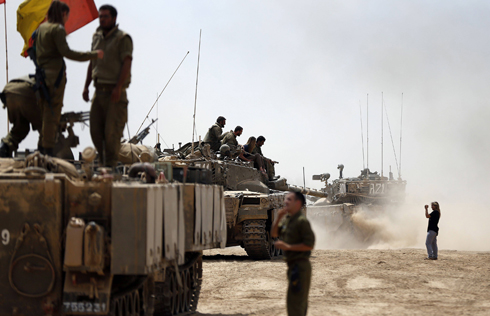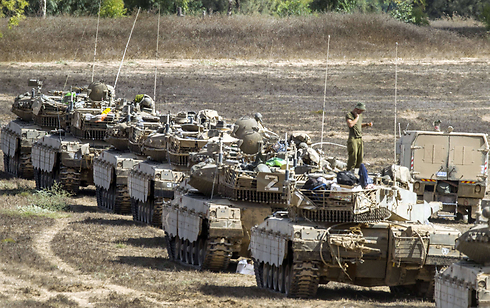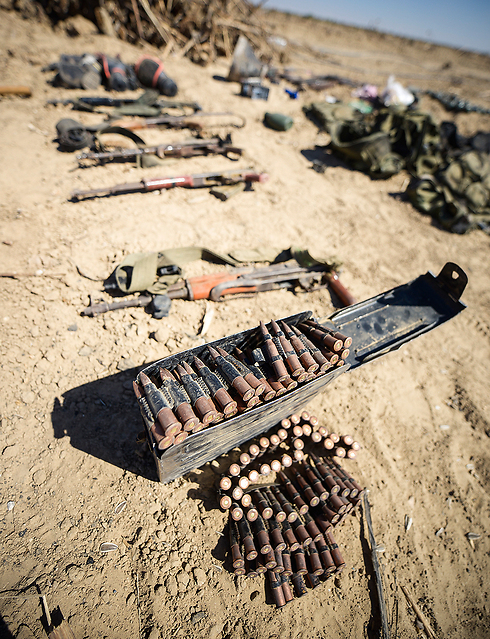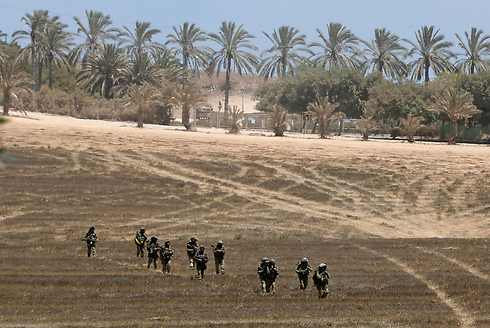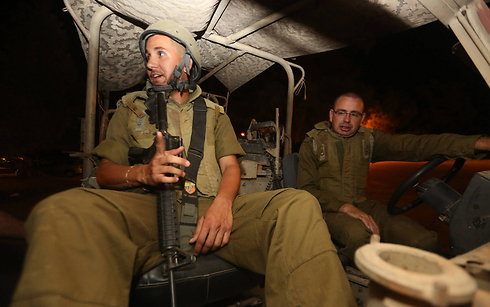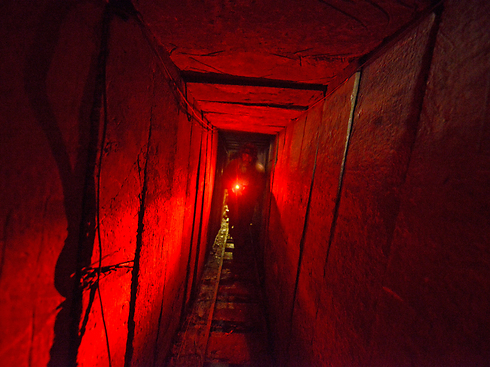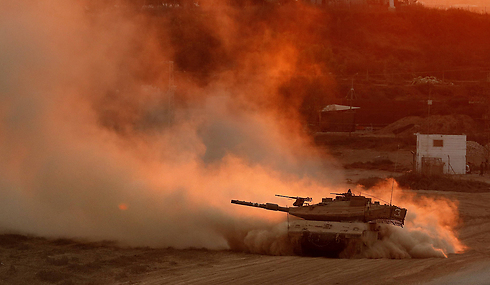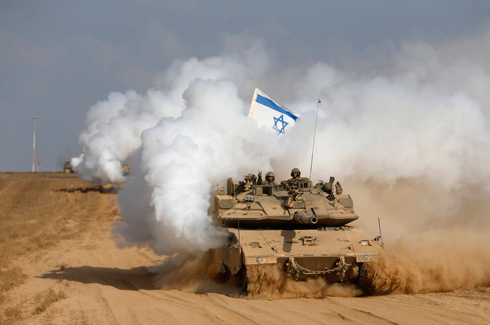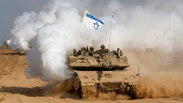
After Protective Edge: Five things for the IDF to think about
Old equipment, a reluctance to go deep into Gaza, inadequate protection of soldiers - after 29 days of fighting, the military will now have some questions to answer.
On Tuesday, the IDF completed 29 days of fighting, which included various ground, sea and air assaults on the Gaza Strip.
Overnight Monday, hundreds of tanks, armored personnel carriers and artillery units were pulled out of the Strip, and in the division and brigade headquarters, discussions began regarding the conclusions of, investigations into and most likely changes and upgrades in the IDF power structure following the operation.
Declarations regarding the success or failure of the operation will be measured over time, and not tomorrow or the next day.
One must bear in mind heavy criticism leveled at the political and military echelons at the end of the Second Lebanon War, a campaign that brought rare quiet to the north, and compare that to the cries of praise sounded after Operation Cast Lead, which only wrought a partial and short-lived deterrence.
But for now, despite the significant damage inflicted on Hamas by the IDF (a Military Intelligence Directorate source says that the organization is left with less than one-third of the rockets with which it began, and suffered the destruction of 60% of its weapon development facilities), the military must meditate on a few negative issues that have surfaced.
1. Inadequate protection of soldiers
A. The IDF does not yet know exactly what caused the deaths of seven Golani fighters who were killed when their outdated armored personnel carrier (APC) became bogged down in the neighborhood of Saja'iyya. The crushed APC is still being inspected and the army is currently examining the possibility that it was hit by an anti-tank missile that had an explosive device attached.
It is almost ironic that the attack came as the troops were using a relatively outdated APC, a rare event as the Infantry Corps mainly use a much newer vehicle.
Military sources explain that even after the incident took place, this model of APC was used in the Strip due to a shortage of newer models, and because this is the only APC equipped with mortars. These APCs are also designated for logistical supply missions.
Yet another consideration touches upon the protection from mortar shrapnel, to which forces on the ground are more vulnerable than those travelling in armored vehicles.
Furthermore, lighter vehicles such as small jeeps to evacuate casualties were used in the Strip, some entirely open-topped – even after the incident – in an attempt to balance the need of evacuating casualties quickly against the dangers of travelling in safer areas.
B. Mortar shelling of IDF meeting points. The primitive weaponry of WWII has succeeded where advanced M-75 and M302 rockets, which reached Tel Aviv, Jerusalem and the Carmel area, have failed. The rockets also claimed the lives of nine soldiers at meeting points - and of one civilian at Erez Crossing.
The army has actually drawn conclusions from Operation Pillar of Defense and the deadly rocket barrage that claimed the lives of 12 reservists in Kfar Giladi in the 2006 Lebanon War – and developed radar to detect mortar shells, to which it attached siren systems, specifically made to be used in assembly areas.
However, according to testimonies of soldiers, not enough portable bomb shelters were dispersed throughout the area, forcing soldiers to rely on luck most of the time.
A military official stressed that during operations, mortar shells would forever be a statistical weapon, and that most of its launches do not hit the target. He added that in a situation in which masses of soldiers are concentrated so close by to the border due to operational reasons, it only makes sense that there will be several cases of direct hits.
3. Bulletproof vests. During Operation Protective Edge, a shortage of bullet-proof vests equipped with monolithic ceramic plates was discovered. Once again, this is not a case of exact science, since such bulletproof vests are considered heavy and encumber the soldier during attacks, as opposed to the shrapnel-proof vests that weigh less.
After several soldiers were wounded, the IDF distributed hundreds of ceramic bullet-proof vests to fighters in the Strip. Even then, there was a noticeable shortage in the field, and the ceramic vests were distributed sparingly, and only in the most threatened areas.
2. Readiness of troops
A senior IDF officer stated that by June 15, the army had completed its preparations for what Hamas had defined earlier in the year as the "July war". A division training session was carried out, and by spring, orders were given to the relevant brigade and regiment commanders. However, the army had been preparing for an entirely different operation in the Gaza Strip, which included the attack on Hamas deep in its territory - not the strategically important but relatively limited objective of neutralizing the terrorist tunnels.
The choice of conscript divisions over IDF reserve brigades, in whom full confidence was placed during Operation Pillar of Defense (although they were called up and went through preparations, they did not conduct many maneuvers), raises some questions.
In the IDF's defense, many of the improvisations carried out during the operation were successful: the creative solutions for the destruction of tunnels; the engineering officer from a training base who became a regiment commander due to the growing need for engineering forces; soldiers from an elite fighting unit at the beginning of their service, who were certified overnight to lead forces in an APC used mainly by infantry soldiers.
The military tactics for combat during Operation Protective Edge were written up as soldiers progressed in destroying the tunnels. These tactics expected to result in an upgrade for training in fighting underground, beyond the training sessions currently carried out in practice tunnels at three bases.
3. The incident at Nahal Oz
A senior IDF officer on Tuesday revealed new details about the incident in which five soldiers were killed when terrorists fired at a "pillbox" post in which they were located. According to the new information, almost all the soldiers inside the guard post, including those killed, had been on the alert for an attack, and had opened fire on the militants.
A gunman standing between concrete barricades at a different angle took advantage of an opening to open fire with his machine gun, killing the five soldiers. However, the incident will be considered tragic, not only because of a Hamas propaganda video shot on a GoPro, but because there are still three major questions that need to be answered:
A. Why did troops operating in an area near Saja'iyya not identify the loud skirmish taking place in broad daylight, which included RPG fire on a cylindrical outpost of reinforced concrete?
B. Why weren't the plentiful air and ground-based observation platforms in the area immediately directed to the incident, nor armed with weapons that could have shot the terrorists as they fled back through the fields to the tunnel shaft?
C. Why did the IDF deploy fresh infantry commanders, high-quality fighters whose familiarity with one another was based on several weeks of their course, which hurt their organic structure?
The only soldier who ensured that the incident was serious and not catastrophic was the fighter who stood on the upper post and fired at the militants who tried to drag one of the fallen soldiers with him, and thus prevented the kidnapping of a body.
4. Excessive modesty in fighting
Although the decision was made by the political echelon, time will tell as to what extent the military hierarchy pushed the Cabinet into intensifying the ground offensive against Hamas. Settling for the important but singular aim of neutralizing the tunnels led the IDF to carry out a relatively limited operation against Hamas by land, no more than 2-2.5 miles inside the Strip, without entering into the terrorist strongholds in the neighborhoods of Gaza and Rafah or the refugee camps.
"We were in Beit Hanoun for nine days in which no rockets were fired at Israel, while we found launchers in a schoolyard in one of the neighborhoods," a senior officer said Tuesday. Another senior officer who was asked this week which Hamas targets would be harmed in the case of the expansion of ground operation, replied that the offensive was mainly against command and control targets.
Such operations rooms and communication facilities may not kill like rockets, nor are they as threatening as the tunnels used for cross-border attacks, but they serve as the backbone of Hamas' terrorist cells. The harm inflicted on them by air was only partially successful, due to their proximity to civilian areas. A stronger ground operation would have left Hamas with very little ability to issue commands, directives and instructions to its forces, as it had managed to do until the very last day, including the issuing ceasefire orders for all factions throughout the Strip at exactly 8 am.
5. Tactical intelligence versus strategic intelligence
IDF senior officials, especially among the Military Intelligence Directorate, said several times in the last two weeks that the tunnel threat had been presented to the decision-makers last year, and that intelligence findings had led the army to prepare for a relatively forceful confrontation against Hamas in the summer.
Therefore, the question is why security and military officials, in the weeks that preceded the operation, repeatedly stressed Hamas' terrible plight and its desire to avoid escalation with Israel. If Israel had been prepared for a battle against the organization, why didn't the Cabinet and the IDF choose to be the ones to initiate it, as in Operation Pillar of Defense?
This hesitancy not only helped Hamas officials, including senior commanders of divisions to hide in a timely manner and thus prevent Israel from eliminating terrorist leaders, but also allowed Hamas' advance troops to better prepare for the IDF maneuver, that started with few clashes in the first two days, but as the days went by became more and more dangerous for IDF soldiers, with more booby-trapped houses, anti-tank missiles and sniper squads. Hamas moved from a routine to an emergency situation relatively quickly and effectively.
However, the tactical intelligence broke records during this operation: Junior commanders are saying that they were scarcely surprised by Hamas cells, as the soldiers were supplied with information about the locations of militants, with intelligence coming from Shin Bet interrogation rooms or from drones high in the sky .










